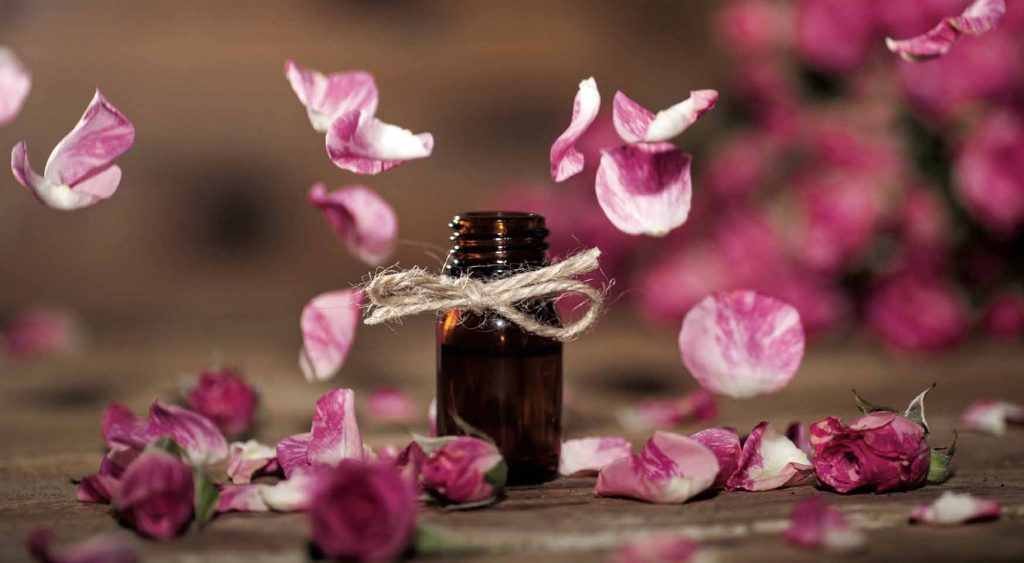FUNCTIONAL FRAGRANCE January 14, 2020
Over the last year, industry headlines have proclaimed ‘functional fragrance’ as a key concept for the future of wellness and olfaction. But isn’t it just the same as aromatherapy? This article deep dives into the context that has opened space for the functional fragrance concept to gain ground and thrive.

We can track a new wave of marketing efforts rooted in the flavour and fragrance industry that herald the arrival of a new, highly innovative cultural synthesis that will purportedly change the way we engage with our sense of smell: functional fragrance. Advocates would have us believe that functional fragrance represents the apex of the holistic look-good-do-good movement that makeup and haircare have been part of for years – headlining products that combine noteworthy aesthetic impact with health-enriching benefit, whether that be cell repair, moisturisation, antiageing, vitamin delivery, UV protection or anxiety reduction, stress relief, anger management, emotional detoxing. Crucially, these remedial claims have, to a greater and greater degree, become platformed by naturals – essential oils in particular. Keen industry eyes would see functional fragrance as an attempt to revive the principles of aromatherapy. This essay examines the social and industrial context that birthed the concept of functional fragrance, why it’s carrying weight with consumers and what it could mean for the industry.
Adina Grigore, founder of skincare brand S.W. Basics, commented that “the idea behind functional fragrance is that it’s actually doing something to help you” whilst journalist Mellanie Perez considers it “a buzzy term that describes scents that “biohack” our brains and bodies to perform better…”
What is it?
 The defining attribute of functional fragrance is that its role is not just to smell good, or just to perform a healthboosting task, but to do both at the same time, equally well, with equal weight put into the development of each of its operational poles so the consumer perceives the olfactive hedonic as part-sensorial indulgence and part-operational remedy. Early adopters have attempted to position functional fragrance offerings as data-backed neurological modifiers that fulfil multiple purposes (physical, emotional and cerebral) by affecting hormone response and cognitive patterning from olfactory stimuli, with clear aspirations towards the DIY preventative medicine market, burnt-out millennials wanting a quick fix for their stress as well as jaded healthcare consumers that think their doctors are keeping something from them. Adina Grigore,
The defining attribute of functional fragrance is that its role is not just to smell good, or just to perform a healthboosting task, but to do both at the same time, equally well, with equal weight put into the development of each of its operational poles so the consumer perceives the olfactive hedonic as part-sensorial indulgence and part-operational remedy. Early adopters have attempted to position functional fragrance offerings as data-backed neurological modifiers that fulfil multiple purposes (physical, emotional and cerebral) by affecting hormone response and cognitive patterning from olfactory stimuli, with clear aspirations towards the DIY preventative medicine market, burnt-out millennials wanting a quick fix for their stress as well as jaded healthcare consumers that think their doctors are keeping something from them. Adina Grigore,
founder of skincare brand S.W. Basics, commented that “the idea behind functional fragrance is that it’s actually doing something to help you” whilst journalist Mellanie Perez considers it “a buzzy term that describes scents that “biohack” our brains and bodies to perform better”, adopting findings that indicate effectiveness specifically for “irritation, stress, depression, apathy, happiness, sensuality, relaxation and stimulation”.
Sound familiar? Perez gave a nod to the aromatherapy industry in her note that “what used to be simply a lavender essential oil to induce sleep a few years ago is now an anti-anxiety solution” whereas the 2019 Global Wellness Summit directly acknowledged its appropriation by suggesting that the marketing term “functional fragrance” represents “Aromatherapy 2.0”, satisfying the needs of today’s consumer base in new ways, “including 100 percent natural ingredients, transparency, sustainability and evidence-based results”. Market frontrunners include Aeroscena and its trademarked “phyto-inhalants”, Osea and its “Vagus Nerve Oil” and The Nue Co, whose flagship functional fragrance induced a feeling of calm in 96% of test subjects.
Why is it happening now?
Functional fragrance subtly diverges from traditional aromatherapy in its cultural bracketing and historical routing. The frame that floats functional fragrance is anobsession with hyper-performance and personality optimisation through artificially intelligent diagnostics, thriving within today’s hive headspace of anxiety epidemics and fear of missing out (FOMO) in the experience economy; in contrast, aromatherapy evokes post-war images of group meditation for some younger demographics and continually ebbed and flowed in and out of public consciousness from the 1970s to today with varying degrees of success. Functional fragrance presents new-to-market brands a chance to revive the values of aromatherapy under a new title and of-the-moment concerns.
Running with a parallel argument, Forbes contributor Deborah Weinswig thinks that “in an era in which so many catalogue their lives on social media, looking great, feeling good and sleeping well are the new luxuries that consumers want to enjoy and flaunt”, continuing that “owning the most expensive or the latest goods has taken a back seat to looking good and feeling good, and consumers are showing an increasing preference for participating in activities and indulging in experiences that promote their well-being”. In corroboration, reporter Zoe Weiner notes that “in 2002, the hottest new perfumes were all about smelling like either cotton candy or your favourite pop star … Fast forward 16 years … we’ve started spritzing ourselves for a very, very different reason: to feel better”.
With a savvy consumer base that is demanding more efficacious and emotionally fulfilling solutions from every consumer product on the shelf, the winners will be those that understand the power of brand empathy in the digital age and offer ever-more bespoke ways for people to shape who they are, how they perform and how they feel by using noninvasive tools that have the ability to respond in real time to the changing physical and emotional needs of the user. The priorities of global tech innovation are largely the same, and aromatherapeutic programmes have the potential to achieve high impact in the high-tech frameworks of the near future, as suggested by biotech experimenter Zyto.
For several years now, wearable devices have gathered data about our heart rates, how many calories we burn, and even our galvanic skin response. This and other data [in the future] will be gathered to create “digital selfies” of individuals. Our digital doubles will be recognisable to machines and therefore will be able to be decoded for enhanced well-being … smartphones will be able to use data to understand our behaviour patterns and recognize our emotions in real time. Technologies that determine these states and behaviours that could be attached to apps include facial recognition, voice recognition, and biometric sensors. In turn, apps will be capable of communicating our emotional state and making recommendations for improving our well-being in real time.
With unease, Dazed Digital’s Geraldine Wharry points out that “we hacked nature during the second industrial revolution without facing the long-term consequences on our planet. Today, we are onto our next challenge: hacking the brain and the human body… Wellness is our era’s catalyst”, echoed by researcher Ophelia Yeung’s remark that “as people incorporate more of the wellness values into their lifestyle, our interaction with the wellness economy is also becoming less episodic and more intentional, more integrative, and more holistic … Everything is merging as companies capitalize on wellness, making it harder to separate markets into individual buckets”.7 The platform of functional fragrance could be poised to steal the wellness podium as a manifest form of mindfulness that could exploit the multiplicity of touchpoints at which finer curation of your emotions would be helpful – think the office (concentration), gym (energy) or dating (confidence).
…In an era in which so many catalogue their lives on social media, looking great, feeling good and sleeping well are the new luxuries that consumers want to enjoy and flaunt…
How far can it go?

Despite predictions that the global aromatherapy market will reach 9.57 billion USD by 2026, some are concerned about the recent drop in pace of inner market activity.8 Functional fragrance, and the F&F industry more widely, presents a huge opportunity for aromatherapy that has room to grow. The fragrance sector is much larger, expected to inflate to 91.17 billion USD by 2025; the wellness market overall, including all product and subcategories, is even larger than that and was valued in 2018 at 4.2 trillion USD, growing 12.8% from 2016 and representing 5.3% of global economic output.9 Instead of worrying about potential oversaturation and inability to induct new aromatherapy users from extraneous markets, it may be smarter to strategise tactics for how to convert the sea of wellness advocates into recognising the benefits that aromatherapy has to offer to their current wellness regime.
If the aromatherapy world doesn’t maintain pace with the rest of the innovation ecosystem in beauty, wellness, tech and beyond then there is a high risk that it will lose its edge in a marketplace that is providing ever more diverse and niche products and services through which consumers can tackle their emotional wellbeing. A reinvigorated effort to fine-tune phytochemical research and further validate the usefulness of essential oils for addressing the concerns of the contemporary user will ensure that naturals remain a cornerstone solution for mood modification. As more and more consumers look for superlative functionality in their fragrances, the role of natural essential oils and the values they represent will become increasingly important in a society obsessed with hyper-performance.
Eddie Bulliqi
 Ultra International B.V.
Ultra International B.V.